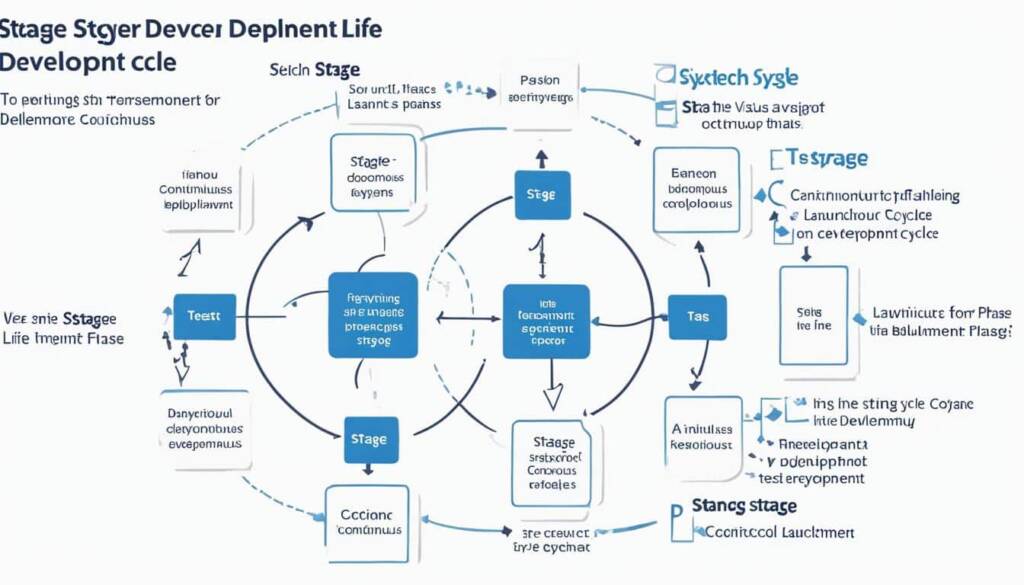Table of Contents
The system development life cycle (SDLC) is a conceptual model used in project management for information system development. It encompasses various stages involved in a development project, from feasibility study to maintenance. SDLC applies to both technical and non-technical systems. It involves the participation of project and program managers, system and software engineers, development teams, and end-users. SDLC provides a structured framework to define the phases and steps of system development. It includes various methodologies such as the Waterfall model, rapid application development (RAD), joint application development (JAD), and Agile software development. Documentation is a crucial aspect of SDLC, regardless of the chosen model. The steps in SDLC can vary but typically include analysis, planning and requirements, design, development, testing, deployment, and maintenance.
SDLC methodologies provide guidance for the development process. The Waterfall model is the original SDLC method, which follows a sequential flow from one phase to another. Other methodologies include rapid application development (RAD), joint application development (JAD), the spiral model, build and fix, and synchronize-and-stabilize. Agile software development is a popular model that emphasizes iterative development and collaboration among cross-functional teams. SDLC methodologies can be combined to create hybrid approaches. Documentation is a crucial aspect of all SDLC models, and it is usually done in parallel with the development process. The success of a project depends on how closely the plan is followed.
Following a defined SDLC model offers several benefits. It provides a clear view of the entire project, including the involved stakeholders, estimated costs, and timelines. SDLC helps project managers establish a projected base cost for the project and ensures that goals and standards are clearly defined. It also allows developers to adapt and make adjustments if something does not go as expected. However, there are also disadvantages to consider. Unforeseen circumstances can complicate the development process and increase costs. Some SDLC methods may lack flexibility, and estimating the overall cost at the beginning of a project can be challenging. Additionally, testing at the end of development can slow down some development teams. Overall, an effective SDLC methodology can lead to successful project outcomes, but it is important to consider both the advantages and disadvantages.
SDLC Methodologies
SDLC methodologies play a crucial role in guiding the development process. They provide a structured framework that ensures projects are executed efficiently and effectively. Let’s explore some of the most commonly used methodologies:
1. Waterfall Model
The Waterfall model is the original SDLC method, characterized by its sequential flow from one phase to another. It follows a linear approach, where each phase is completed before moving on to the next. This methodology is ideal for projects with well-defined requirements and minimal changes during development.
2. Agile Software Development
Agile software development is a popular and flexible methodology that focuses on iterative development and collaboration among cross-functional teams. It emphasizes adaptability, allowing project teams to respond to changing requirements and deliver increments of the product in short development cycles known as sprints.
3. Rapid Application Development (RAD)
With RAD, development teams prioritize rapid prototyping and iteration to quickly deliver functional software. This methodology emphasizes stakeholder involvement and feedback throughout the development process, ensuring the final product meets user expectations.
4. Joint Application Development (JAD)
JAD is a collaborative approach that brings together stakeholders, end-users, and development teams to define requirements and develop solutions. This methodology encourages active participation, allowing everyone involved to have a clear understanding of the project goals and requirements.
These are just a few examples of the SDLC methodologies available. In practice, organizations may choose to combine elements from different methodologies to create hybrid approaches that best suit their specific project requirements. Regardless of the chosen methodology, proper documentation is essential throughout the development process to ensure clarity and facilitate effective communication.
In the next section, we will discuss the advantages and disadvantages of following an SDLC approach in software development.
Advantages and Disadvantages of SDLC
Implementing a defined SDLC model offers numerous advantages. Firstly, it provides project stakeholders with a comprehensive overview of the entire project, encompassing various aspects such as stakeholders involved, estimated costs, and project timelines. This clarity aids project managers in establishing a projected base cost for the project, ensuring goals and standards are clearly defined from the outset. Furthermore, SDLC allows developers to adapt and make adjustments if unforeseen circumstances arise, enabling them to overcome challenges effectively.
However, it is crucial to consider the disadvantages of SDLC as well. Unanticipated complications during the development process can lead to increased costs and project delays. Additionally, some SDLC methods may lack flexibility, which can hinder development teams when they need to respond to changing requirements. Estimating the overall cost at the beginning of the project can also be challenging, as certain factors may only become apparent during the development stages. Moreover, conducting testing at the end of the development process may slow down certain development teams.
It is important to weigh both the advantages and disadvantages when considering an SDLC methodology. While SDLC can significantly contribute to successful project outcomes, it is vital to carefully evaluate the specific circumstances and requirements of each project to determine the most suitable approach. By doing so, the benefits of SDLC can be maximized while minimizing potential drawbacks, leading to efficient and effective system development.
FAQ
What is the system development life cycle (SDLC)?
The system development life cycle (SDLC) is a conceptual model used in project management for information system development. It encompasses various stages involved in a development project, from feasibility study to maintenance.
Who is involved in the SDLC process?
The participation of project and program managers, system and software engineers, development teams, and end-users is important in the SDLC process.
What are some commonly used methodologies in SDLC?
Some commonly used methodologies in SDLC include the Waterfall model, rapid application development (RAD), joint application development (JAD), and Agile software development.
Why is documentation important in SDLC?
Documentation is a crucial aspect of SDLC, regardless of the chosen model, as it helps in maintaining records and providing a reference for future developments.
What are the steps involved in SDLC?
The steps in SDLC can vary, but typically include analysis, planning and requirements, design, development, testing, deployment, and maintenance.
Can SDLC methodologies be combined?
Yes, SDLC methodologies can be combined to create hybrid approaches that suit the specific needs of a project.
What are the benefits of following a defined SDLC model?
Following a defined SDLC model provides a clear view of the entire project, including stakeholders, estimated costs, and timelines. It helps in establishing a projected base cost, defining goals and standards, and allows for adaptability and adjustments during development.
What are the disadvantages of SDLC?
Some disadvantages of SDLC include unforeseen circumstances that can complicate the development process and increase costs, lack of flexibility in some methodologies, challenges in estimating overall costs at the beginning, and potential slowing down of development teams during testing.












